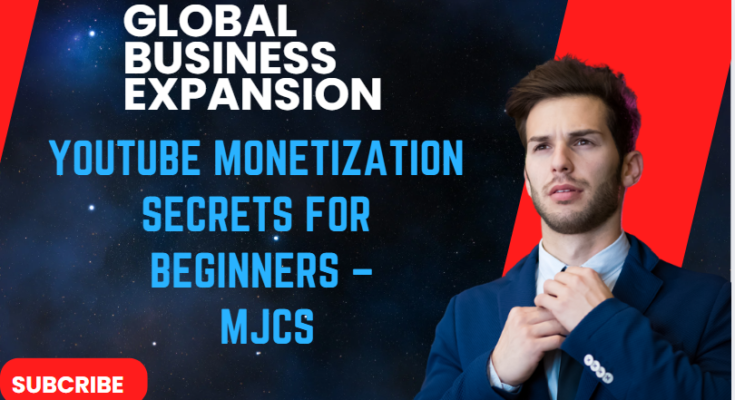YouTube has transformed from a platform for entertainment to a full-fledged revenue-generating machine for content creators. With over 2 billion active users every month, it offers endless opportunities for aspiring creators to earn money doing what they love. Whether you’re new to YouTube or you’ve been creating content for a while, the key to success lies in mastering YouTube monetization.
In this guide, we’ll unveil the secrets behind YouTube monetization, breaking it down into manageable steps for beginners. From meeting the eligibility criteria to exploring diverse revenue streams, you’ll discover how to start earning on YouTube in 2025.
1. What is YouTube Monetization?
Before diving into the details, let’s first understand what YouTube monetization is. Monetization on YouTube refers to the process of earning money from the content you upload. There are several ways to monetize your channel, and the revenue you earn comes from a combination of ads, memberships, sponsorships, and affiliate marketing. However, becoming a monetized creator takes more than just uploading videos—it requires a strategic approach and commitment to growing your channel.
2. Key Methods of YouTube Monetization
There are several ways to monetize your content on YouTube. Let’s break down the most effective and popular methods:
2.1 YouTube Partner Program (YPP)
The YouTube Partner Program (YPP) is the most common and direct way to earn money from your videos. When you join YPP, YouTube places ads on your content, and you get a share of the revenue generated from those ads. To qualify for YPP, your channel needs to meet the following requirements:
- 1,000 Subscribers: You must have at least 1,000 subscribers.
- 4,000 Watch Hours: Your videos must accumulate at least 4,000 watch hours over the past 12 months.
- AdSense Account: You need a linked AdSense account to receive payment.
- Compliance with YouTube’s Community Guidelines: You must follow YouTube’s rules, avoiding inappropriate or harmful content.
Once you meet these criteria, you can apply for monetization via the YouTube dashboard. If approved, ads will appear on your videos, and you’ll earn money based on views and engagement.
Tip: Focus on producing content that is both engaging and shareable. This can help you grow your subscribers and watch hours faster.
2.2 YouTube Premium Revenue
In addition to ads, you can earn money through YouTube Premium. YouTube Premium is a subscription service where users pay for an ad-free experience. As a creator, you still receive revenue from Premium members who watch your videos. This creates an additional, steady income stream without the need for ads.
2.3 Channel Memberships
Once you have 30,000 subscribers, you can enable Channel Memberships. This feature allows viewers to become paying members of your channel for a monthly fee, often around $4.99. In return, they get special perks such as:
- Custom badges and emojis for use in comments and live chats.
- Access to exclusive members-only posts.
- Early access to new content.
Channel memberships are a great way to generate consistent income, especially if you have a loyal fanbase.
2.4 Super Chat & Super Stickers
For creators who do live streams, Super Chat and Super Stickers are excellent tools to increase your earnings. Viewers can pay to highlight their messages in live chat (Super Chat) or buy fun, animated stickers (Super Stickers) to show their support.
These features are available during live streams and can significantly boost your income if you engage actively with your audience.
2.5 Affiliate Marketing
If you’re not yet eligible for YouTube Partner Program or if you want to diversify your income, affiliate marketing is another option. This involves promoting third-party products or services in your videos and earning a commission for every sale made through your unique affiliate link.
There are various affiliate networks such as:
- Amazon Associates
- Click Bank
- Share A Sale
By placing affiliate links in your video descriptions, you can earn passive income as viewers click and purchase products you’ve recommended.
2.6 Sponsored Content
As your channel grows, you may attract sponsors looking to promote their products or services. Brands often pay creators to feature their products in videos, whether through a direct product review, a tutorial, or a casual mention.
Sponsorships can provide significant earnings, especially for creators with a highly engaged audience. If you’re looking to land sponsorships, consider platforms like Grapevine, Channel Pages, and Fame bit.
2.7 Selling Merchandise
Once your channel reaches a certain level of growth (usually around 10,000 subscribers), you can sell merchandise directly through YouTube. This is done by linking your channel to merchandise partners like Tee spring or Spread shop, which allow you to create and sell your branded products, such as T-shirts, mugs, and phone cases.
Merchandise sales can become a solid revenue stream, especially if your brand or content resonates with your audience.
3. How to Qualify for YouTube Monetization
To start making money on YouTube, you must first qualify for the platform’s monetization options. Here’s a step-by-step breakdown:
Step 1: Create High-Quality Content
Your content is the heart of your channel, so focus on producing videos that resonate with your target audience. Choose a niche that you’re passionate about and produce valuable content consistently. The more engaging your videos are, the more likely they are to get shared and recommended, increasing your watch time and subscribers.
Step 2: Grow Your Audience
YouTube rewards creators with more subscribers and watch hours. The key to growing your audience is consistency and engagement. Post new videos regularly and interact with your viewers in the comments and during live streams. Engage with your audience and listen to their feedback to improve your content.
Step 3: Apply for the YouTube Partner Program
Once you’ve reached 1,000 subscribers and 4,000 watch hours, you can apply for monetization through the YouTube Partner Program. Navigate to your YouTube dashboard, click on the Monetization tab, and follow the steps to link your AdSense account and apply.
YouTube will review your channel, and if everything checks out, they’ll approve you for monetization. Once approved, you can start earning money from ads and other monetization features.
Step 4: Adhere to YouTube’s Guidelines
Adhering to YouTube’s Community Guidelines is crucial to maintain your monetization status. Violations of YouTube’s rules, such as uploading inappropriate content, can result in your monetization being disabled or even a channel strike.
4. Tips for Growing Your Channel and Earning More
Now that you understand how YouTube monetization works, here are some practical tips to maximize your earnings:
4.1 Focus on Consistency
To maintain and grow your audience, create a regular upload schedule. Consistency in posting videos helps you build momentum and keeps your subscribers coming back for more.
4.2 Optimize for YouTube Search
Just like with Google, YouTube uses an algorithm to determine which videos are suggested to users. Optimize your videos for SEO by using targeted keywords in your video titles, descriptions, and tags. Also, don’t forget about custom thumbnails and engaging titles that entice people to click on your videos.
4.3 Engage with Your Audience
Engagement is a two-way street. Respond to comments, ask for feedback, and create content that encourages viewers to participate. The more you engage with your audience, the stronger your community will become, leading to increased loyalty and support.
4.4 Explore Other Revenue Streams
While YouTube ads are a great start, they shouldn’t be your only source of income. Explore affiliate marketing, sponsorships, merchandise sales, and other methods to diversify your income. The more revenue streams you have, the more stable your earnings will be.
5. Common Mistakes to Avoid
Achieving success on YouTube takes time, but there are common pitfalls that many creators fall into:
5.1 Ignoring Content Quality
While quantity is important, never sacrifice the quality of your content. If you want your audience to stay engaged, your videos need to provide value. Invest in good equipment and learn the basics of video editing to ensure your content looks professional.
5.2 Neglecting SEO
Without proper SEO, your videos may go unnoticed. Make sure your video titles, descriptions, and tags include relevant keywords. Also, use custom thumbnails to increase your click-through rates (CTR).
5.3 Inconsistent Uploads
Inconsistency can hurt your channel’s growth. Develop a content calendar and stick to a regular posting schedule to keep your audience engaged.



